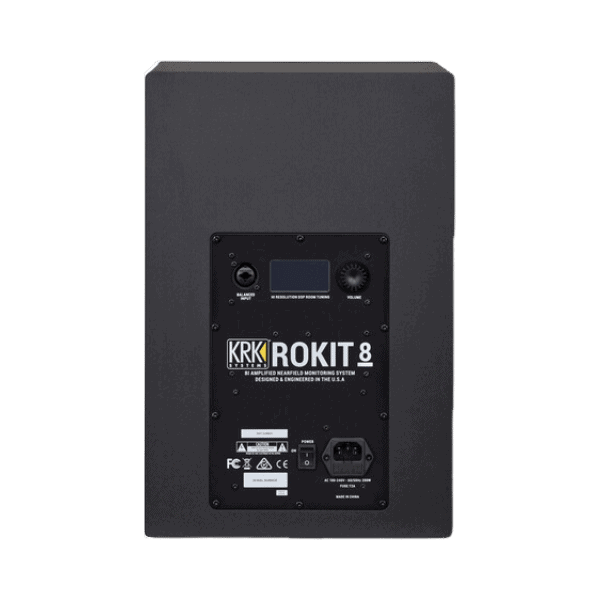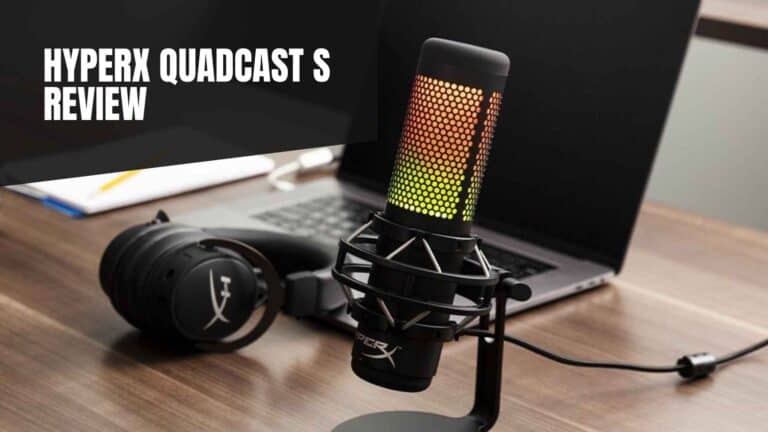KRK ROKIT 8 G4 Review: The Best Budget Studio Monitors?
The name KRK Systems carries significant weight in the music industry. However, while the previous generation of the KRK ROKIT has aesthetically pleasing designs, their sonic performance left much to be desired. The upper mid frequencies were noticeably lacking, resulting in a muddy sound profile, and the bass was overemphasized to a fault.
The latest KRK ROKIT 8 G4 studio monitor is not merely an incremental improvement over the 5-inch and 7-inch monitors that are often the starting point for many in the field of music production. It represents a quantum leap in terms of sound quality and performance. KRK Systems has taken the feedback and criticisms of their previous models seriously, using them as a springboard for developing a superior product.
In this KRK ROKIT 8 G4 review, we will examine this studio monitor’s incredible features and performance characteristics, its latest upgrades like the LCD display with onboard DSP, and the KRK Audio Tools app.
Rest assured, the ROKIT 8 G4 does not merely meet expectations in this regard – it surpasses them, delivering a sonic experience that is nothing short of spectacular.
At a Glance
The KRK ROKIT 8 G4 is a significant upgrade from its predecessors and has redefined its audio performance standards with an all-new Kevlar cone woofer and tweeter. The sound is crisp, warm, and punchy, no longer overly heavy in the bass, and it has a flat response, making it great for analytical listening and mixing.
Its robust construction and aesthetic appeal are complemented by an onboard Digital Signal Processor (DSP) with an LCD display, allowing easy visualization of EQ settings for room correction. Its free KRK Audio Tools App also helps you quickly set up your monitors for the best sound quality.
Pros
Cons
Design and Build Quality

The KRK ROKIT 8 G4 is a studio monitor that seamlessly blends aesthetic appeal with robust build quality. While it maintains a look largely similar to the previous G3 series monitors, it offers several aesthetic enhancements.
Constructed with high-end materials, and weighing in at 22.6 lbs. (10.25 Kg.), it possesses a substantial heft often indicative of superior build quality. Despite its robust construction and high-end materials, it remains budget-friendly compared to other brands with similar specifications, offering exceptional value.
The studio monitor’s professional appearance is characterized by a clean, refined look. The iconic yellow coned woofer, a signature of the ROKIT series, has been toned down to a less overbearing hue, offering a subtle nod to its predecessors without being overly bright. The black tweeter of the previous models has also been replaced with a yellow one, further enhancing the monitor’s unique visual appeal.
One simple but thoughtful feature of the KRK ROKIT 8 G4 is the inclusion of isolation pads at the bottom of the studio monitor. This is often a separate but necessary purchase with other monitors for enhancing their stability and reducing unwanted vibrations, so it is great that KRK includes this for free.
The monitor’s front cover can be removed and replaced with metallic grille covers, protecting the drivers from pesky pets like cats and careless kids. These covers are held firmly in place by strong magnets, and they’re so strong you might think the front cover was screwed into the cabinet!
The ROKIT 8 G4 has moved away from the angular edges of the previous G3 series monitors, adopting a more streamlined look. The shiny plastic of the front panel has been replaced with a textured matte finish, imparting a sophisticated aesthetic. The front bass port is wider than the G3 model, a design modification that further enhances the monitor’s already excellent sound quality.
Sound Quality

The KRK ROKIT 8 G4 is a pair of affordable studio monitors with exceptional audio integrity for mixing music.
You are mistaken if you believe these studio reference monitors are merely bass monsters like their predecessors. Unlike the previous models that utilized a glass-Aramid composite woofer with a 1” soft-dome tweeter, the G4 model incorporates low-distortion Kevlar cones for both drivers.
These Kevlar cones, characterized by their stiffness and lightness, effectively control the low ends and reverb, resulting in an agile and reactive performance which is great for flat response listening. This, coupled with its low resonance enclosure, enhances the accuracy and exhibits a flatter frequency response compared to the older G3 series monitors.
The high-ends are crisp and clean, devoid of harshness, and possess a sufficient presence in the air frequencies to provide the listener with a sense of spaciousness.
In contrast to the previous generation of Rokit G series monitors, which tended to exaggerate the low-end and mid-frequencies, the bass response of the KRK ROKIT 8 G4 is tighter and less resonant, while the mid-range is clear, revealing intricate details in a mix.
The mid frequencies are also warm and soothing, and together with the studio monitors’ well-defined bass and crisp top end, they contribute to a balanced and neutral sound across the frequencies. This neutrality ensures the monitor does not induce listening fatigue over extended mixing sessions.
The KRK ROKIT 8 G4 studio monitor boasts a high total power output of 203W, with 68W allocated for the high-frequency amp and 135W for the low-frequency amp. The monitor employs high-quality Class D amps, which are more efficient and operate at lower temperatures than the Class A/B amps used in previous models.
As mentioned, the ROKIT 8 G4 has a larger front-firing bass port than the older G3 model, reducing the need for precise placement away from walls, unlike monitors with rear ports.
The monitor’s stereo imaging is excellent, enabling the listener to discern and locate the placement of instruments within the mix. The sound remains clear and balanced at louder volumes without distortion, and the monitor exhibits impressive sound dispersion, allowing for a wider sweet spot.
It is worth noting that the KRK ROKIT 8 G4 may require a break-in period of 12-24 hours of music playback to achieve optimal sound performance.
Rear Panel

The rear panel of the KRK ROKIT 8 G4 features a standard XLR-¼” TRS combo jack for accepting balanced line input. This is a more modern approach than other studio monitors, such as the Yamaha HS8, which separates the analog input connections for XLR and ¼” TRS.
Also present is a socket and power switch for activating the unit. However, it’s not the XLR jacks or power socket that will catch your eye, right? The first thing you’ll probably notice is the LCD display and volume control dial, which I will get into next.
Visual LCD with Onboard DSP

The KRK ROKIT 8 G4 studio monitor introduces a unique game-changer feature: the Visual LCD screen with an onboard Digital Signal Processor (DSP). One great thing about the DSP controls on the LCD is that it is pretty simple and intuitive, that you would not need much instruction to get started.
This LCD screen, located at the rear of the monitor, allows you to control the DSP-driven onboard Equalizer (EQ) and adjust the acoustic profile of the monitor with up to 25 EQ presets. The volume knob also doubles as a button for confirming selections, a clever design choice that streamlines the user interface.
In addition to the onboard controls, the KRK ROKIT 8 G4 offers a free KRK Audio Tools app that provides access to more tuning features on the DSP, which I’ll get into later.
This is an advantage over most other studio monitors, which typically offer simple switches and knobs for EQ settings without an LCD display for visualizing the settings. Even high-end studio monitors like the ADAM Audio A8H, which have DSPs for tweaking their acoustic profile, require a connection to a computer and the use of software and lack an LCD panel for on-the-fly adjustments.
Upon powering up the KRK ROKIT 8 G4 and being taken to the Home Screen, you might initially be disappointed by its seemingly pixelated display and small size.
However, these initial impressions are quickly overshadowed by the practicality and functionality of the display. It is sufficient for visualizing and making the necessary EQ changes, providing real-time feedback on the volume and current EQ setting.
The volume knob on the Home Screen allows you to adjust the speakers’ volume in steps of 0.1 dB, a handy feature when connecting to professional or consumer-level devices that output different signal strengths. Pressing the volume knob grants you access to the menu and EQ settings page to make EQ adjustments for room correction.

The onboard DSP offers a range of EQ options, including the L.SHELF (low shelf) cut option for reducing low-end frequencies when the studio monitors are placed close to a wall that might cause excessive bass resonance.
The L.PEQ (low parametric EQ) cut affects only a portion of the frequencies around the set frequency, helping to mitigate large desk reflections in the lower-mid frequencies that can cause muddiness.
There is also an L.SHELF boost for those moments when you crave some extra bass, perhaps reminiscent of the old bass-intense KRK ROKIT models.
The H.SHELF (high shelf) and H.PEQ (high parametric EQ) settings are less about tuning the studio monitor to adapt to room acoustics and more about adjusting the tonality to suit your mixing taste. Whether you prefer a bright or a darker tone, the KRK ROKIT 8 G4 has you covered.
The onboard DSP also offers a range of other settings, including adjusting the backlight and contrast of the LCD display. You can even control the lighting for the KRK logo on the front panel, adding a touch of ambiance to your studio space. The ‘standby mode’ allows the studio monitor to sleep after 30 minutes of inactivity, reactivating when the signal returns.
One particularly impressive function of the onboard DSP is its built-in Brickwall Limiter. This feature automatically cuts off clipping audio, maintaining a balanced sound and protecting the system. This is another example of how the KRK ROKIT 8 G4 goes above and beyond to deliver a superior audio experience.
KRK Audio Tool App

The KRK Audio Tools App is a free, handy application designed to assist you in setting up your KRK ROKIT 8 G4, or any studio monitors for that matter.
It is available for download on both Android Playstore and iOS App Store. There are six audio tools in the KRK app, and all of them, except the EQ Recommendation tool, will work with any monitor setup. Talk about KRK being generous!
Besides the Monitor Align Tool and Spectrum RCA Tool, you’ll need a ⅛” headphone to dual ¼” Y-cable splitter to connect your smartphone to your KRK ROKIT 8 G4 to use most of these tools. This lets your smartphone play pink or white noise through the ROKIT monitors.
However, don’t expect the app to make changes to the settings inside the onboard DSP. It’s more of an analysis tool than a remote control for your studio monitors.
Monitor Align Tool

The Monitor Align Tool helps you set the angle of the studio monitors to 30 degrees to form an equilateral triangle for that perfect phantom center.
You start by positioning your monitors around 1 to 1.5m apart, facing them straight out without any inward angle.
Then, you select either the left or right monitor, place your phone on the monitor, and rotate the monitor until the graphic on the phone shows 30 degrees. Repeat this step on the other studio monitor, and you’ve got yourself a perfectly aligned setup.
Spectrum RTA Tool

This tool is a real-time spectrum analysis used for analyzing the frequency vs. amplitude in real-time. It uses a sound generator to show your room frequencies with different sound signals like pink noise, white noise, sine wave, and continuous sine sweep.
This tool can help you identify different acoustic problems in your room. It also has a peak hold function that lets you freeze the frequency curve at its highest point.
When you tap the screen, a cursor display will appear, showing you the frequency and amplitude values. Now, you can identify and deal with those problematic frequencies with the highest amplitudes.
Delay Tool

The Delay Tool measures the distance between your studio monitors and your listening position. It’s essentially a sonic measuring tape.
You start by bringing your smartphone close to one of the speakers and press the play button to get a reference position. Then return to your listening position and hit the play button again to get the actual delay time (or distance) between the speaker and your listening position.
I must say, I am very impressed that the Delay Tool can measure distance pretty accurately. However, I find it quite redundant because you can simply use a measuring tape for this same purpose.
EQ Recommendation Tool

Remember the EQ settings on the LCD screen at the rear panel I was talking about just now? If you’re having a hard time choosing the correct settings, the EQ Recommendation Tool is a life-saver.
To use this tool, you will need to be in your ideal listening position and tap on the play button. You will then need to move your phone in a slow figure-8 pattern around this listening spot for around 20 seconds till the analysis is done.
The tool will then recommend an EQ setting which you will need to set on the LCD screen at the rear panel.
But remember, this is not a hard and fast rule. You don’t have to stick to this setting diligently and can adjust to whatever makes you comfortable.
Polarity Tool

The Polarity Tool is used to check whether the studio monitors are wired correctly. The wrong polarity will lead to the sound being out of phase, which can cause bass loss and inaccurate stereo imaging.
Using this tool is pretty simple. You need to ensure the volume of the monitors is sufficiently tuned up, then bring your smartphone close enough to one of the speakers and press the play button. Getting a green + indicates the correct polarity, while a red – means it is the wrong polarity.
Level Meter Tool

Last but not least, the Level Meter Tool is used to check that studio monitors in your studio setup are of the same volume level.
You will need to be in your listening position when you activate this tool. The green bar is the RMS value, while the yellow bar is the peak value.
Final Verdict

The KRK ROKIT 8 G4 studio monitor is a remarkable blend of aesthetic appeal, robust construction, and superior audio performance.
The build quality is commendable, demonstrating a commitment to durability and longevity. The inclusion of isolation pads is a thoughtful addition, indicative of KRK’s attention to detail and understanding of the user’s needs.
The audio quality of the KRK ROKIT 8 G4 is exceptional. The bass frequencies are well-controlled and precise, the mid-range frequencies are warm and detailed, and the high frequencies are crisp and clear. This balanced, neutral sound profile ensures reliable and accurate audio representation for critical listening and professional mixing tasks.
The standout feature of the KRK ROKIT 8 G4 is undoubtedly the onboard Digital Signal Processor (DSP) with an LCD display. This innovative feature allows users to fine-tune the monitor’s acoustic profile, offering a level of customization that is uncommon in this product category.
The accompanying KRK Audio Tools App further enhances the user experience, providing useful tools for optimizing the audio setup.
So, is the KRK ROKIT 8 G4 worth your hard-earned cash? For a reasonable price of $300 per piece, it definitely is. It’s a studio monitor that punches well above its weight, delivering a knockout performance that will leave you dazed and amazed.
If you’re beginning your journey in music production and searching for affordable, high-quality large studio monitors for your recording setup, the KRK ROKIT 8 G4 is an excellent choice.
It’s particularly suitable if you’re establishing a home studio on a tight budget and need equipment that pairs well with other budget-friendly devices, such as audio interfaces.
However, if you have a higher budget, you might want to consider other high-quality professional studio monitors we recommend.
Production Information
Specifications
- Power Configuration: Bi-amped
- LF Driver Size: 8″ woofer
- LF Driver Type: Kevlar cone
- HF Driver Size: 1″ tweeter
- HF Driver Type: Kevlar dome
- Total Power: 203W Class D
- LF Driver Power Amp: 135W
- HF Driver Power Amp: 68W
- Frequency Response: 36Hz-40kHz
- Maximum Peak SPL: 111 dB SPL
- Input Types: 1 x balanced XLR-1/4″ TRS combo
- Weight: 22.6 lbs (10.25 Kg)
Features
- Low-distortion Kevlar drivers for balanced and controlled sound
- Class D power amplifier drives the speakers evenly at reduced operating temperatures
- DSP with room tuning and 25 EQ settings adjustable through LCD display
- Built-in Brick Wall Limiter maintains a balanced sound with wider dynamics and protects the system
- High-density Iso-foam pad at the base of the speaker
- KRK App with a spectrum analyzer, monitor alignment, delay tool, polarity tool, level meter tool, and EQ recommendation

KRK ROKIT 8 G4










